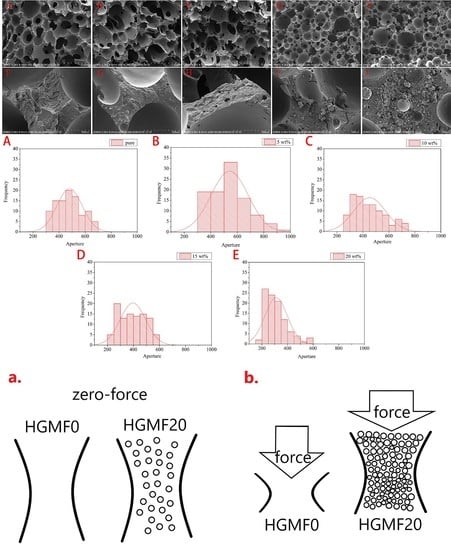Functional Hollow Ceramic Microsphere/Flexible Polyurethane Foam Composites with a Cell Structure: Mechanical Property and Sound Absorptivity
Abstract
:1. Introduction
2. Materials and Methods
2.1. Materials
2.2. Preparation
2.3. Characterization
2.3.1. Surface Observation
2.3.2. Compressibility Test
2.3.3. Drop Weight Impact Test
2.3.4. Sound Absorptivity Test
3. Results and Discussion
3.1. Stereomicroscopic Observation
3.2. Effects of HCM on Cell Size of Flexible PU Foam
3.3. SEM Observation
3.4. Effect of HCM Content over Compressibility of Composites
3.5. Effect of HCM Content over Impact Resistance of Composites
3.6. Effect of HCM on Sound Absorption Coefficient of Composites
4. Conclusions
Author Contributions
Funding
Institutional Review Board Statement
Informed Consent Statement
Data Availability Statement
Acknowledgments
Conflicts of Interest
References
- Gwon, J.G.; Kim, S.K.; Kim, J.H. Sound absorption behavior of flexible polyurethane foams with distinct cellular structures. Mater. Des. 2016, 89, 448–454. [Google Scholar] [CrossRef]
- Sung, G.; Kim, K.S.; Kim, W.J.; Kim, H.J. Effect of isocyanate molecular structures in fabricating flexible polyurethane foams on sound absorption behavior. Polym. Test. 2016, 53, 156–164. [Google Scholar] [CrossRef]
- Qian, Y.; Liu, W.; Park, T.Y.; Lindsay, I.C.; Camargo, R.; Macosko, W.C.; Stein, A. Modification with tertiary amine catalysts improves vermiculite dispersion in polyurethane via in situ intercalative polymerization. Polymer 2012, 53, 5060–5068. [Google Scholar] [CrossRef]
- Estravís, S.; Tirado-Mediavilla, J.; Santiago-Calvo, M.; Ruiz-Herrero, J.L.; Villafañe, F.; Rodríguez-Pérez, M. Rigid polyurethane foams with infused nanoclays: Relationship between cellular structure and thermal conductivity. Eur. Polym. J. 2016, 80, 1–15. [Google Scholar] [CrossRef] [Green Version]
- Kurańska, M.; Prociak, A. The influence of rapeseed oil-based polyols on the foaming process of rigid polyurethane foams. Ind. Crops Prod. 2016, 89, 182–187. [Google Scholar] [CrossRef]
- Gama, N.; Costa, L.; Amaral, V.; Ferreira, A.; Barros-Timmons, A. Insights into the physical properties of biobased polyurethane/expanded graphite composite foams. Compos. Sci. Technol. 2017, 138, 24–31. [Google Scholar] [CrossRef]
- Xi, W.; Qian, L.; Huang, Z.; Cao, Y.; Li, L. Continuous flame-retardant actions of two phosphate esters with expandable graphite in rigid polyurethane foams. Polym. Degrad. Stab. 2016, 130, 97–102. [Google Scholar] [CrossRef]
- Wang, W.; Pan, Y.; Pan, H.; Yang, W.; Liew, K.M.; Song, L.; Hu, Y. Synthesis and characterization of MnO2 nanosheets based multilayer coating and applications as a flame retardant for flexible polyurethane foam. Compos. Sci. Technol. 2016, 123, 212–221. [Google Scholar] [CrossRef]
- Gómez-Fernández, S.; Ugarte, L.; Peña-Rodriguez, C.; Zubitur, M.; Corcuera, M.; Eceiza, A. Flexible polyurethane foam nanocomposites with modified layered double hydroxides. Appl. Clay Sci. 2016, 123, 109–120. [Google Scholar] [CrossRef]
- Tian, H.; Yao, Y.; Zhang, S.; Wang, Y.; Xiang, A. Enhanced thermal stability and flame resistance of rigid polyurethane-imide foams by varying copolymer composition. Polym. Test. 2018, 67, 68–74. [Google Scholar] [CrossRef]
- Sung, G.; Yao, Y.; Zhang, S.; Wang, Y.; Xiang, A. Fabrication of polyurethane composite foams with magnesium hydroxide filler for improved sound absorption. Polym. Test. 2016, 44, 99–104. [Google Scholar] [CrossRef]
- Wang, Y.; Wang, F.; Dong, Q.; Xie, M.; Liu, P.; Ding, Y.; Zhang, S.; Yang, M.; Zheng, G. Core-shell expandable graphite@ aluminum hydroxide as a flame-retardant for rigid polyurethane foams. Polym. Degrad. Stab. 2017, 146, 267–276. [Google Scholar] [CrossRef]
- Lee, H.P.; Ng, B.M.P.; Rammohan, A.V.; Tran, L.Q.N. An investigation of the sound absorption properties of flax/epoxy composites compared with glass/epoxy composites. J. Nat. Fibers 2016, 14, 71–77. [Google Scholar] [CrossRef] [Green Version]
- Khaleel, M.; Soykan, U.; Çetin, S. Influences of turkey feather fiber loading on significant characteristics of rigid polyurethane foam: Thermal degradation, heat insulation, acoustic performance, air permeability and cellular structure. Constr. Build. Mater. 2021, 308, 125014. [Google Scholar] [CrossRef]
- Mohammadi, B.; Ershad-Langroudi, A.; Moradi, G.; Safaiyan, A.; Habibi, P. Mechanical and sound absorption properties of open-cell polyurethane foams modified with rock wool fiber. J. Build. Eng. 2021, 48, 103872. [Google Scholar] [CrossRef]
- Li, T.-T.; Liu, P.; Wang, H.; Dai, W.; Wang, J.; Wang, Z.; Shiu, B.-C.; Lou, C.-W.; Lin, J.-H. Preparation and characteristics of flexible polyurethane foam filled with expanded vermiculite powder and concave-convex structural panel. J. Mater. Res. Technol. 2021, 12, 1288–1302. [Google Scholar] [CrossRef]
- Imran, M.; Bandyopadhyay, A.K.; Gandhi, T.K.S.; Rahaman, A.; Chandan, M.R. Mechanical property enhancement of flexible polyurethane foam using alumina particles. Mater. Today: Proc. 2020, 45, 4040–4044. [Google Scholar] [CrossRef]
- Choe, H.; Lee, J.H.; Kim, J.H. Polyurethane composite foams including CaCO3 fillers for enhanced sound absorption and compression properties. Compos. Sci. Technol. 2020, 194, 108153. [Google Scholar] [CrossRef]
- Wang, L.; Aslani, F.; Hajirasouliha, I.; Roquino, E. Ultra-lightweight engineered cementitious composite using waste recycled hollow glass microspheres. J. Clean. Prod. 2020, 249, 119331. [Google Scholar] [CrossRef]
- Gao, G.; Hu, Y.; Jia, H.; Liu, P.; Du, P.; Xu, D. Acoustic and dielectric properties of epoxy resin/hollow glass microsphere composite acoustic materials. J. Phys. Chem. Solids 2019, 135, 109105. [Google Scholar] [CrossRef]
- Pakdel, E.; Naebe, M.; Kashi, S.; Cai, Z.; Xie, W.; Yuen, A.C.Y.; Montazer, M.; Sun, L.; Wang, X. Functional cotton fabric using hollow glass microspheres: Focus on thermal insulation, flame retardancy, UV-protection and acoustic performance. Prog. Org. Coat. 2020, 141, 105553. [Google Scholar] [CrossRef]
- Gogoi, R.; Manik, G.; Arun, B. High specific strength hybrid polypropylene composites using carbon fibre and hollow glass microspheres: Development, characterization and comparison with empirical models. Compos. Part B: Eng. 2019, 173, 106875. [Google Scholar] [CrossRef]
- Herrera-Ramírez, L.C.; Cano, M.; de Villoria, R.G. Low thermal and high electrical conductivity in hollow glass microspheres covered with carbon nanofiber–polymer composites. Compos. Sci. Technol. 2017, 151, 211–218. [Google Scholar] [CrossRef]
- Yang, H.; Jiang, Y.; Liu, H.; Xie, D.; Wan, C.; Pan, H.; Jiang, S. Mechanical, thermal and fire performance of an inorganic-organic insulation material composed of hollow glass microspheres and phenolic resin. J. Colloid Interface Sci. 2018, 530, 163–170. [Google Scholar] [CrossRef] [PubMed]
- Baek, S.H.; Kim, J.H. Polyurethane composite foams including silicone-acrylic particles for enhanced sound absorption via increased damping and frictions of sound waves. Compos. Sci. Technol. 2020, 198, 108325. [Google Scholar] [CrossRef]
- Park, S.J.; Cho, S.H.; Seo, H.W.; Nam, J.D.; Suhr, J. Natural cork agglomerate enabled mechanically robust rigid polyurethane foams with outstanding viscoelastic damping properties. Polymer 2021, 217, 123437. [Google Scholar] [CrossRef]
- Wang, W.; Wang, D.; Xia, B.; Li, T.; Wang, Y.; Zhang, X.; Bai, H.; Chen, M.; Dong, W. Rigid polyurethane foams based on dextrin and glycerol. Ind. Crop. Prod. 2022, 177, 114479. [Google Scholar] [CrossRef]
- Leszczyńska, M.; Ryszkowska, J.; Szczepkowski, L.; Kurańska, M.; Prociak, A.; Leszczyński, M.K.; Gloc, M.; Antos-Bielska, M.; Mizera, K. Cooperative effect of rapeseed oil-based polyol and egg shells on the structure and properties of rigid polyurethane foams. Polym. Test. 2020, 90, 106696. [Google Scholar] [CrossRef]
- Gürgen, S.; Kuşhan, M.C.; Li, W. Shear thickening fluids in protective applications: A review. Prog. Polym. Sci. 2017, 75, 48–72. [Google Scholar] [CrossRef] [Green Version]
- Sujon, M.A.S.; Islam, A.; Nadimpalli, V.K. Damping and sound absorption properties of polymer matrix composites: A review. Polym. Test. 2021, 104, 107388. [Google Scholar] [CrossRef]
- Sukhawipat, N.; Yingshataporn-A-Nan, T.; Minanandana, T.; Puksuwan, K.; Saengdee, L.; Nakaramontri, Y.; Sosa, N.; Saetung, N. Effects of water hyacinth fiber size on sound absorption properties of advanced recycled palm oil-based polyurethane foam composite. Mater. Today Proc. 2021; in press. [Google Scholar] [CrossRef]


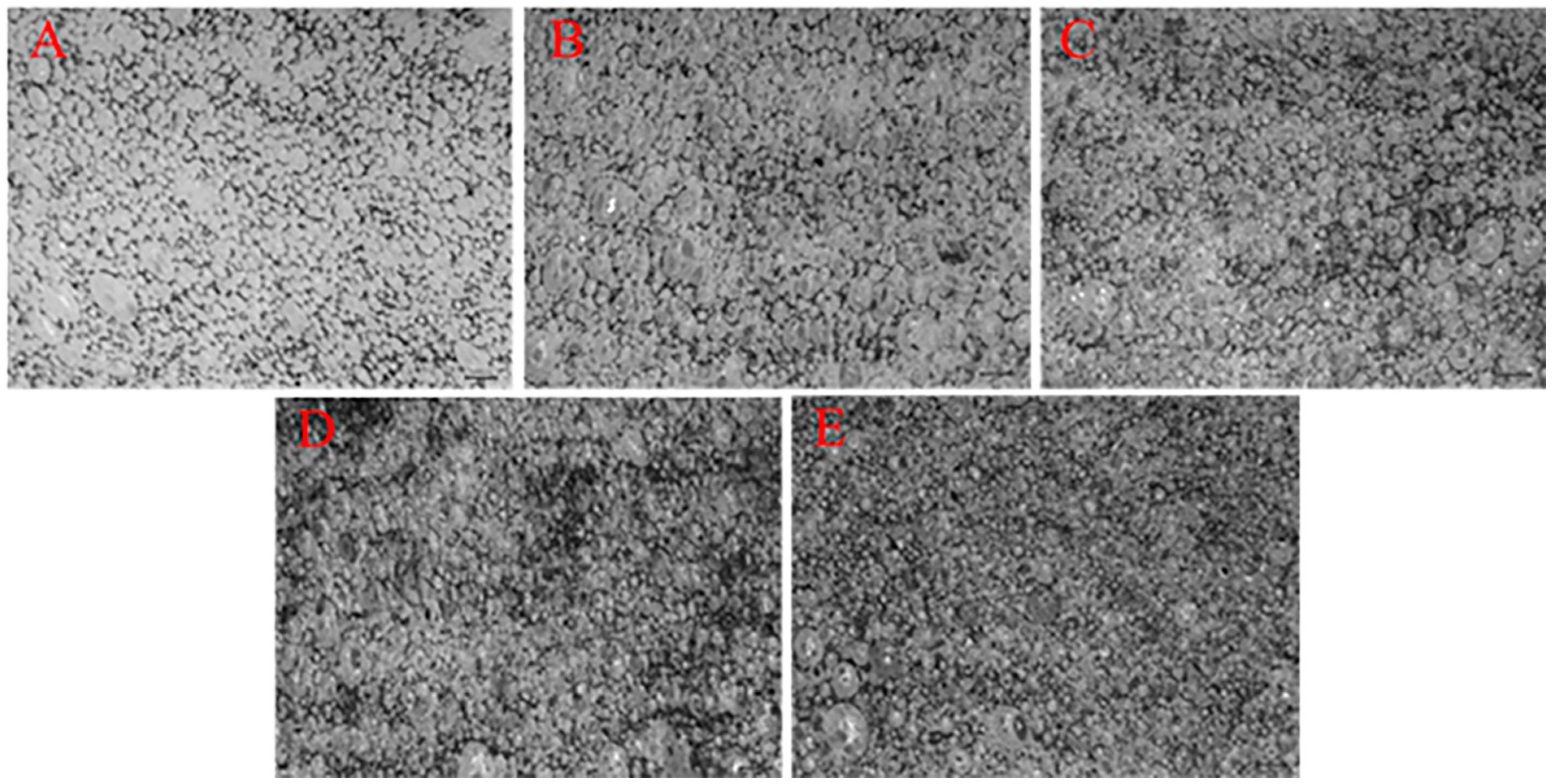

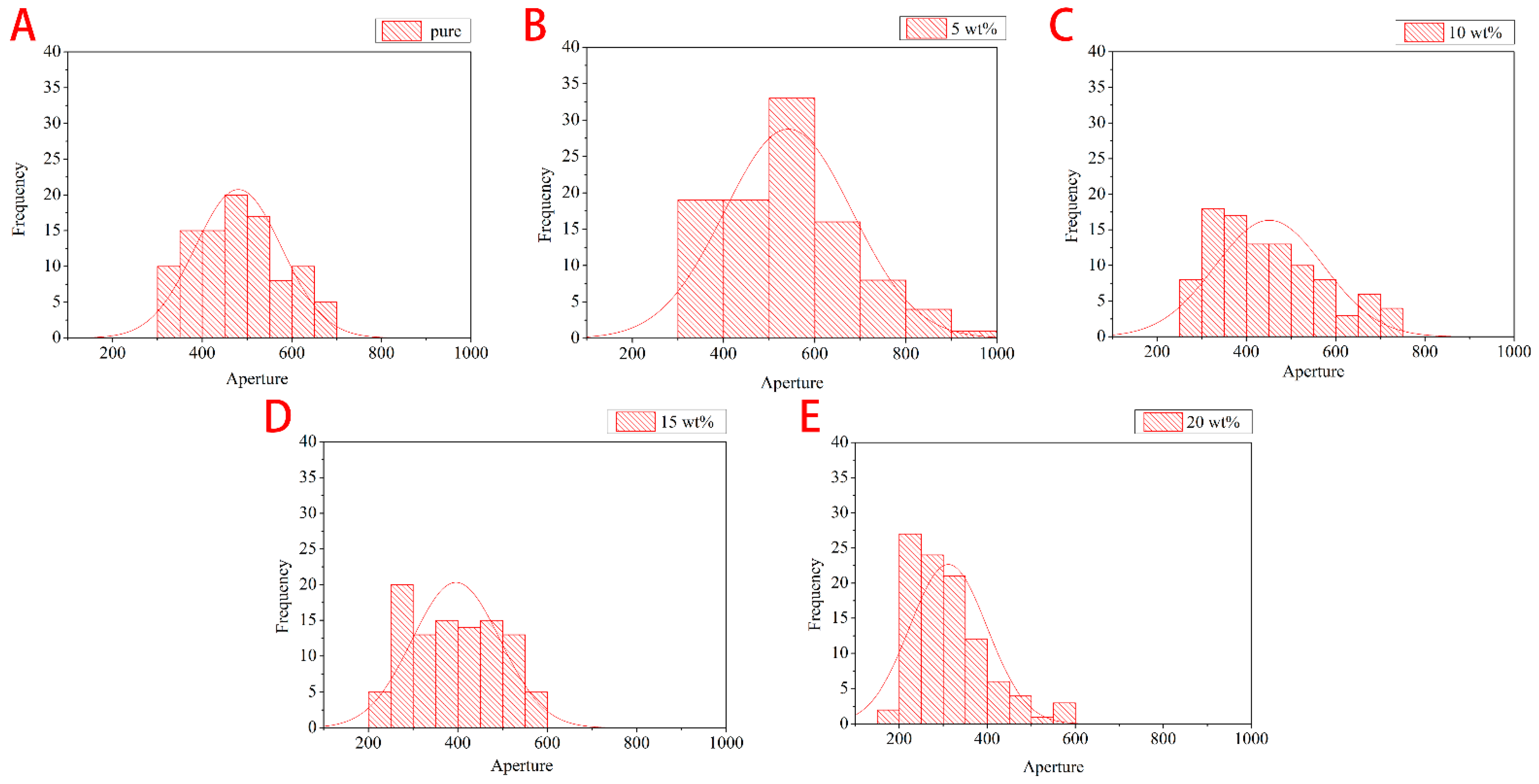
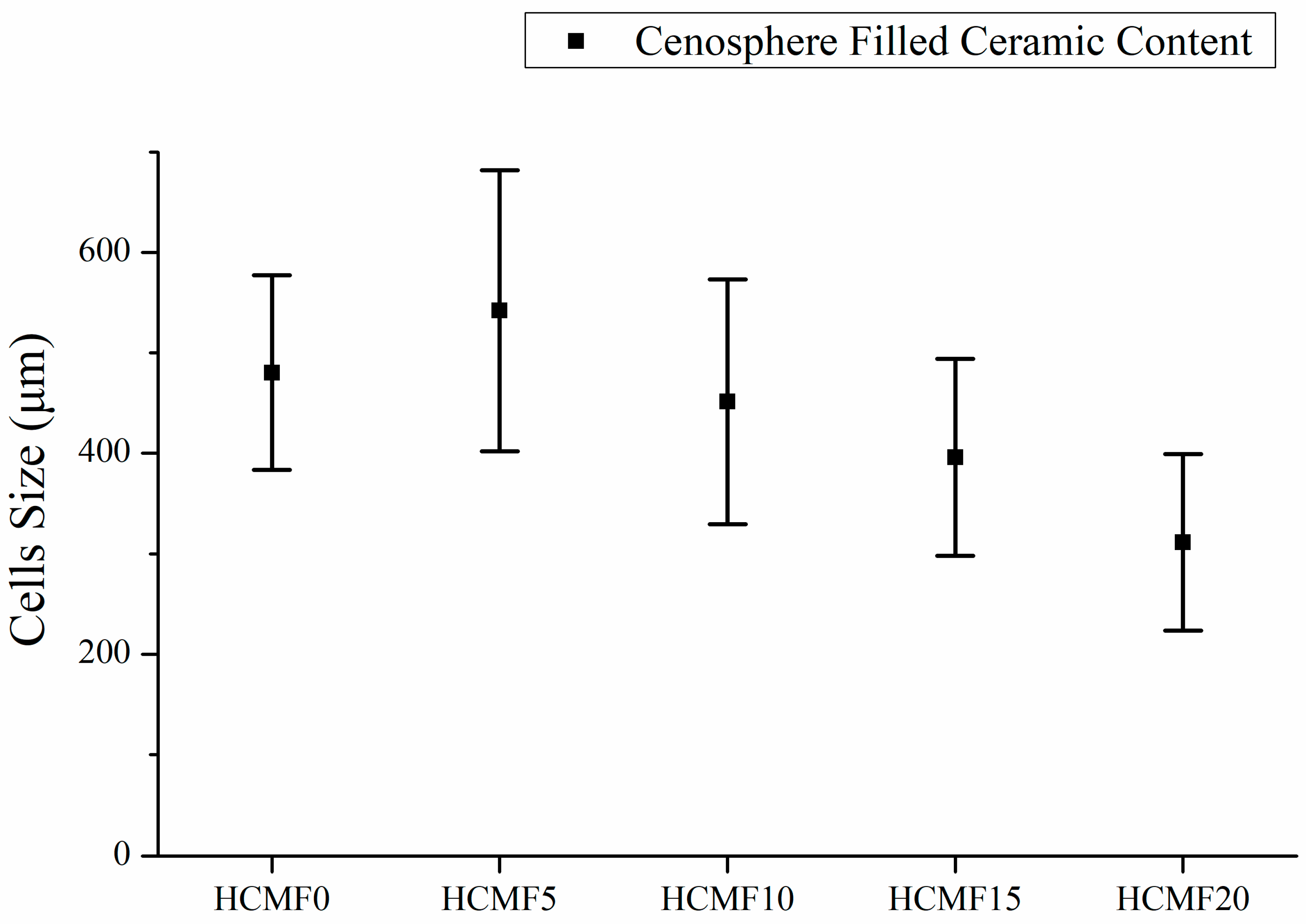


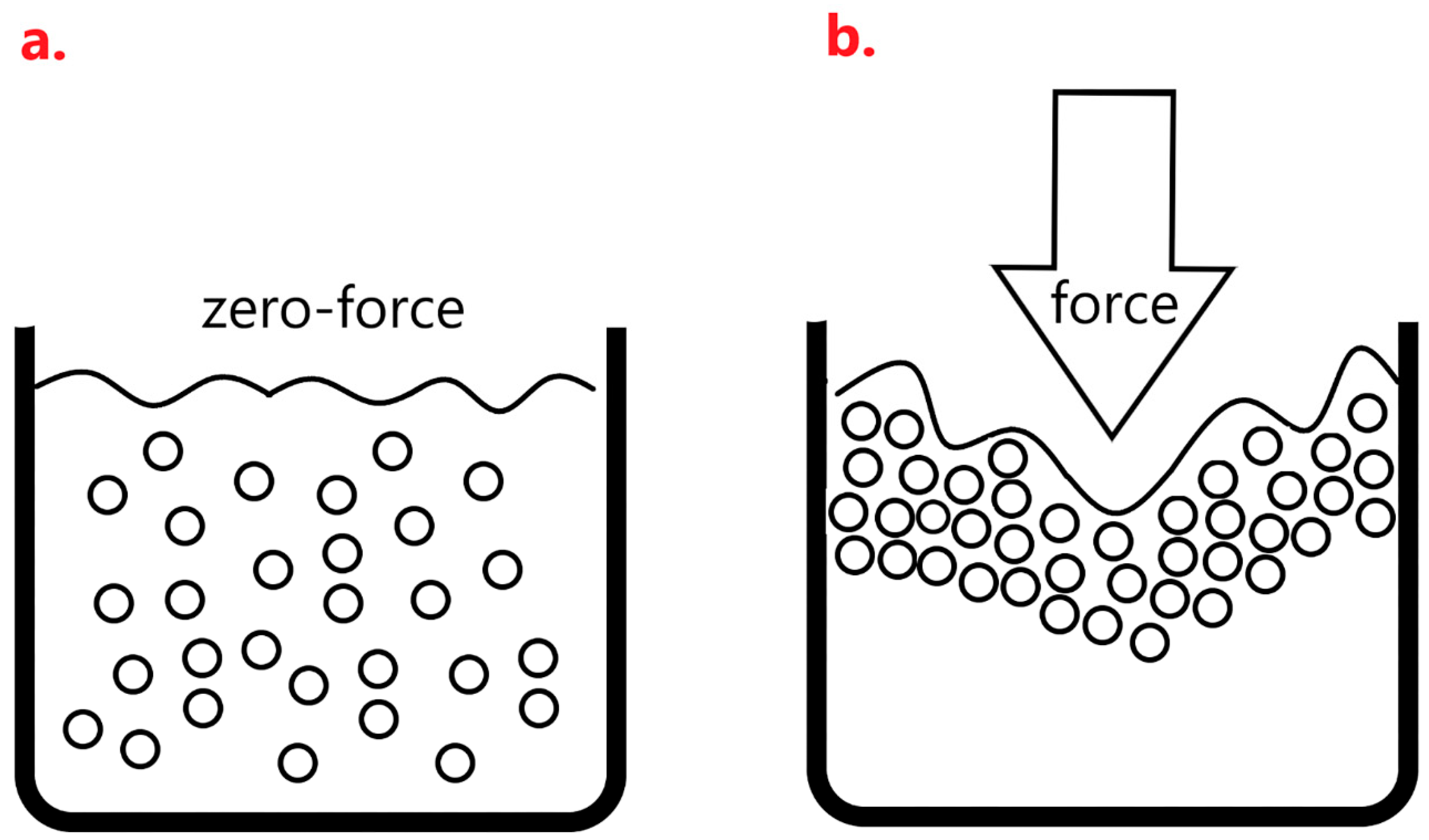
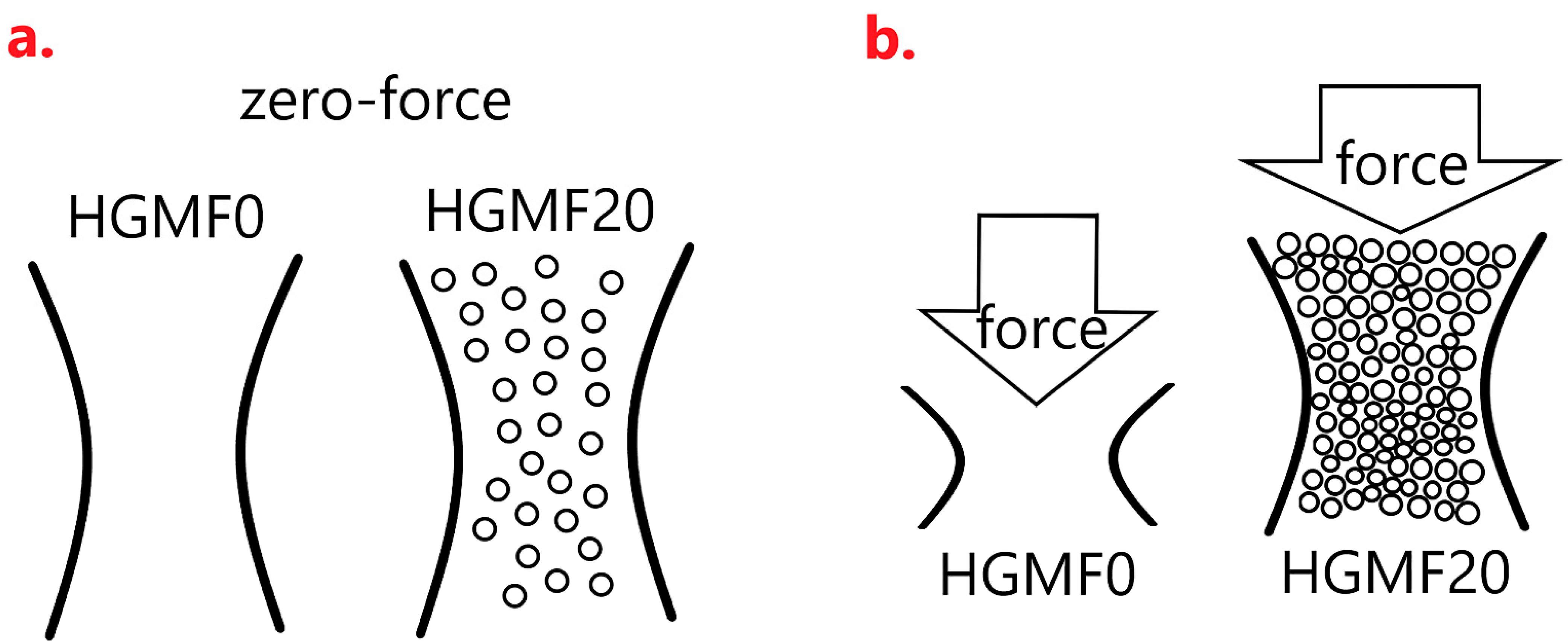
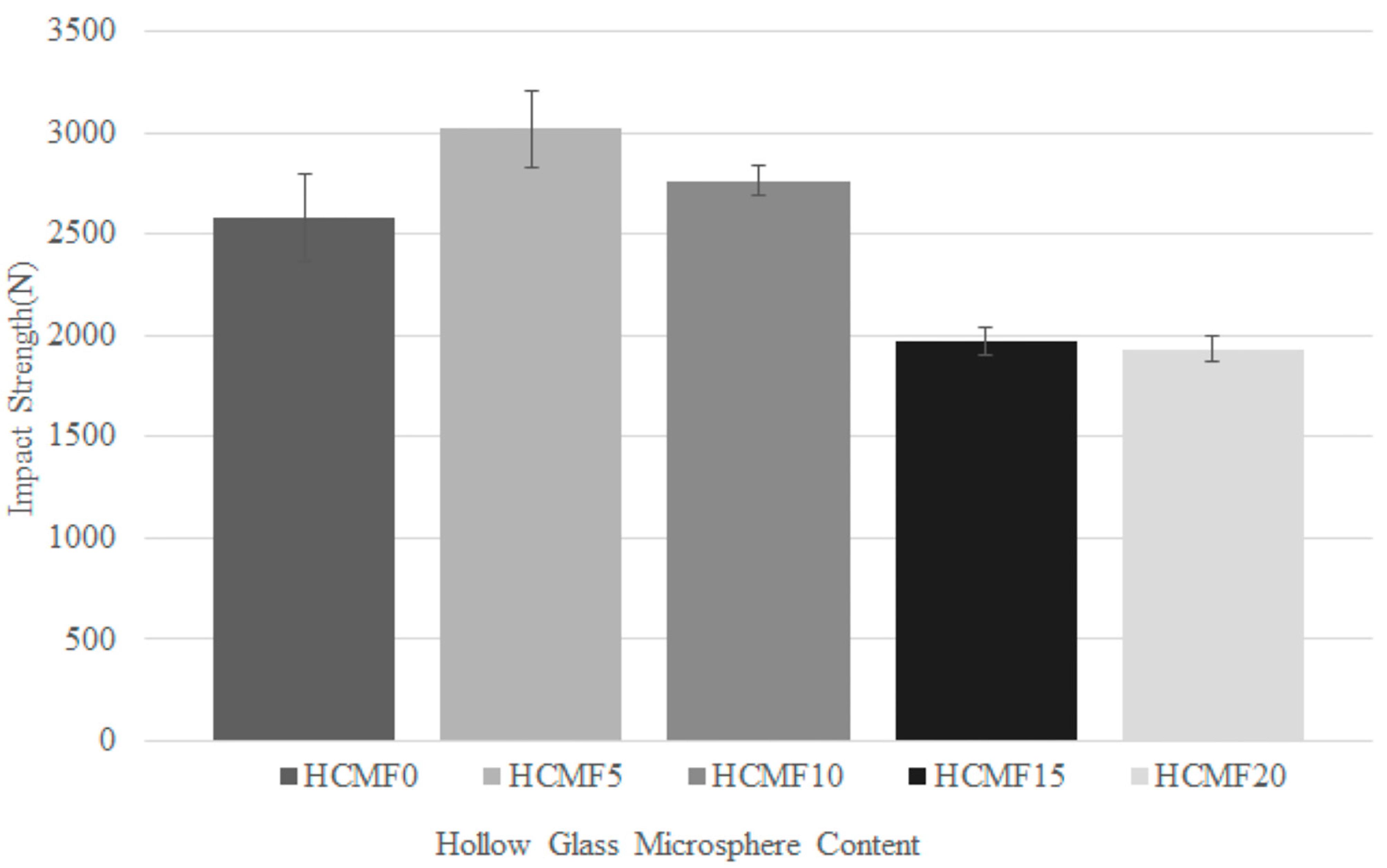
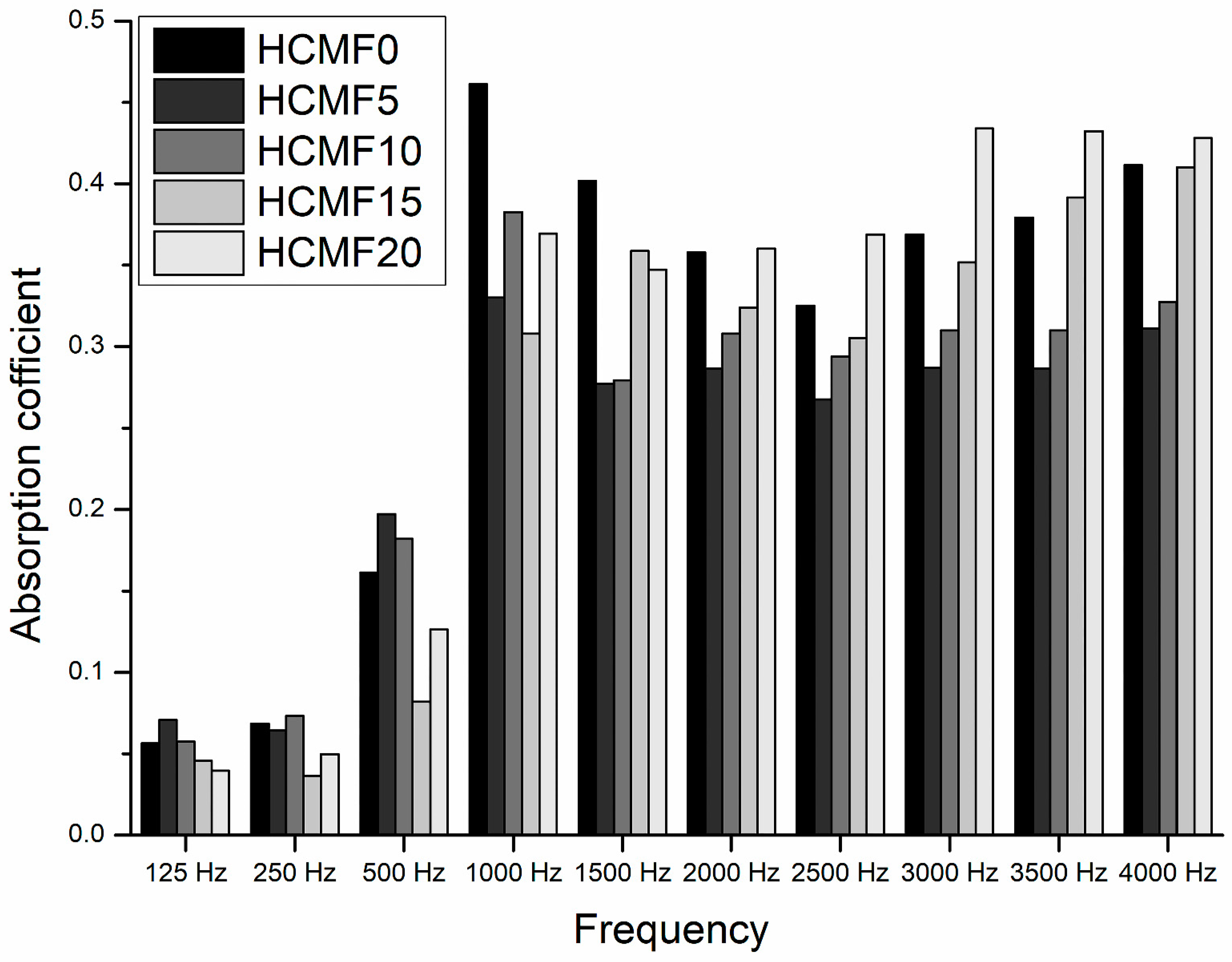
| HCMF0 | HCMF5 | HCMF10 | HCMF15 | HCMF20 | |
|---|---|---|---|---|---|
| PU-A | 80 | 77.5 | 75 | 72.5 | 70 |
| PU-B | 20 | 17.5 | 15 | 12.5 | 10 |
| HCM | 0 | 5 | 10 | 15 | 20 |
Publisher’s Note: MDPI stays neutral with regard to jurisdictional claims in published maps and institutional affiliations. |
© 2022 by the authors. Licensee MDPI, Basel, Switzerland. This article is an open access article distributed under the terms and conditions of the Creative Commons Attribution (CC BY) license (https://creativecommons.org/licenses/by/4.0/).
Share and Cite
Lin, J.-H.; Hsu, P.-Y.; Huang, C.-H.; Lai, M.-F.; Shiu, B.-C.; Lou, C.-W. Functional Hollow Ceramic Microsphere/Flexible Polyurethane Foam Composites with a Cell Structure: Mechanical Property and Sound Absorptivity. Polymers 2022, 14, 913. https://doi.org/10.3390/polym14050913
Lin J-H, Hsu P-Y, Huang C-H, Lai M-F, Shiu B-C, Lou C-W. Functional Hollow Ceramic Microsphere/Flexible Polyurethane Foam Composites with a Cell Structure: Mechanical Property and Sound Absorptivity. Polymers. 2022; 14(5):913. https://doi.org/10.3390/polym14050913
Chicago/Turabian StyleLin, Jia-Horng, Po-Yang Hsu, Chen-Hung Huang, Mei-Feng Lai, Bing-Chiuan Shiu, and Ching-Wen Lou. 2022. "Functional Hollow Ceramic Microsphere/Flexible Polyurethane Foam Composites with a Cell Structure: Mechanical Property and Sound Absorptivity" Polymers 14, no. 5: 913. https://doi.org/10.3390/polym14050913
APA StyleLin, J.-H., Hsu, P.-Y., Huang, C.-H., Lai, M.-F., Shiu, B.-C., & Lou, C.-W. (2022). Functional Hollow Ceramic Microsphere/Flexible Polyurethane Foam Composites with a Cell Structure: Mechanical Property and Sound Absorptivity. Polymers, 14(5), 913. https://doi.org/10.3390/polym14050913







